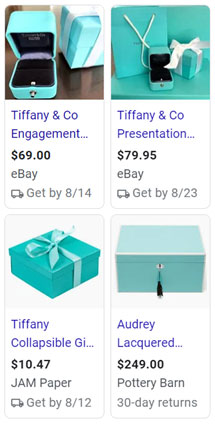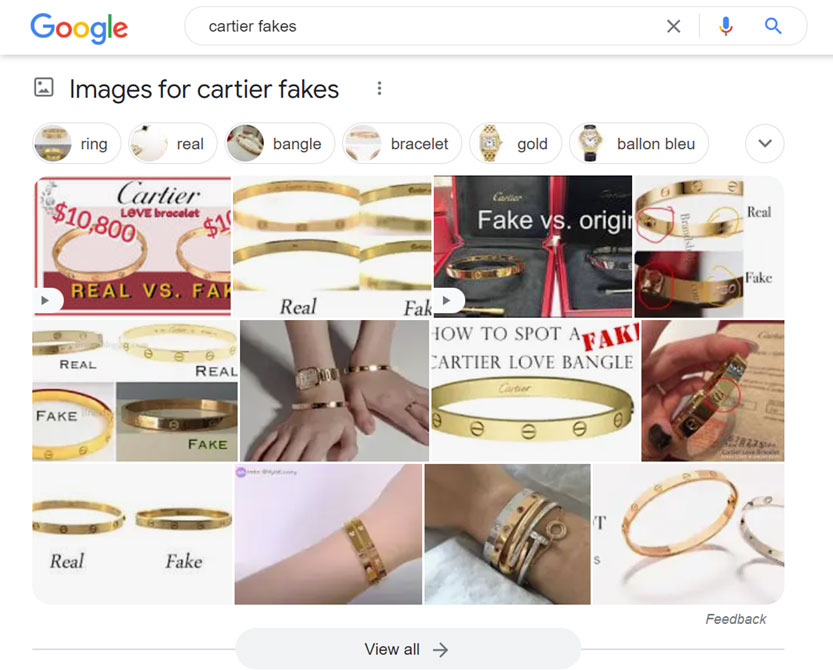
Faking the brands
How much phony brand-name jewelry is out there?
Here's a statistic to consider: Of all the high-value counterfeit items seized by U.S. customs, jewelry tops the list. It's higher than designer handbags and clothing, higher than bogus and potentially dangerous pharmaceuticals, even higher than consumer electronics.
If all the jewelry and watches seized just last year had entered the market and sold at MSRP (Manufacturer's Suggested Retail Price), the total would come to $1,060,787,355. Don't bother counting the zeros – that's well over a billion dollars.
Each year Customs and Border Patrol catches more counterfeit goods. And here's the thing: they can't go through every package, so there is no way of knowing how much is not caught.
Most fake goods aim to fool someone, whether it's the purchaser or people the purchaser wants to impress. But jewelry is the only commodity likely to seriously affect insurers.
NOTE: The following discussion of fakery applies to jewelry in general. Watches are a special category, with unique scams and special caveats for insurers. See our more thorough discussion, counterfeit luxury watches.
Some counterfeits, like the bogus Van Cleef and Arpels bracelet pictured in the online ad shown above, are super-cheap rip-offs. Notice the last word in the ad; it's likely a deliberate misspelling, so the seller can say, "Well, we didn't say it was onyx."
Other fakes are better made, using better materials, and can cost thousands of dollars. So, while not all buyers of counterfeit jewelry will attempt to insure it, some certainly will.
A few scenarios:
A knockoff may come in an impressive box that mimics the brand's presentation, and it may even come with official-looking papers.
Fancy presentation boxes are available online, as are bogus appraisal documents.
The consumer may know they've bought a fake, worth only what they paid (or even less), but attempt to insure it as the real thing.
This is a setup for a convenient loss.
A consumer may actually have been fooled into thinking they've gotten the genuine brand jewelry at a truly bargain price. One buyer of a fake Rolex later took it to Rolex for repairs; of course the company immediately recognized it as counterfeit.
Just because the customer was taken in, the insurer should not be. You need a professional description of the jewelry, where and when it was purchased, and at what price. In short, an appraisal and sales receipt.
Some knockoffs are of shoddy quality, but some are quite good imitations. Appraisers who are not aware of their own lack of expertise might appraise a fake as genuine.
Be sure the appraiser is familiar with the kind of jewelry being appraised, knows the current market for such jewelry, and is aware of any current scams.
The policy-holder may buy a replica of name-brand jewelry that looks good enough to pass as the real thing and try to insure it as that.
When it comes to brand-name jewelry, "replica" is another word for "fake." A number of websites openly advertise replica jewelry. These sellers are not trying to fool the buyer – but beware that the buyer doesn't try to fool the insurer. Always check for evidence of brand authenticity.
What to be wary of:
- No docs, no sales receipt
Major red flag! If it's a recent purchase, the owner should definitely have documents that:
describe the jewelry
show the price paid
carry the seller's name and contact info
Unhappy shopper's tale:
"I purchased 5 pieces of jewelry from different sellers and tested them when I got them and they were all fake. . . . [They are all] stamped as being 925, 10k, or 14k. One item is even a David Yurman stamped replica ring. They turned the color of a penny after testing them with jewelry acid."
– Consumer on a complaint website
For an older piece—inherited jewelry, for example—ask about prior insurance. If there's no prior insurance on a high-value item, why not?
- Purchased on secondary market
Flea markets, online auctions, and friends-of-friends are always suspect. Sellers may deliberately misrepresent their wares, or they may not even know the quality of what they are selling and just make something up to sound good. Require an appraisal from an appraiser who is knowledgeable about such jewelry and can recognize counterfeits.
- Purchased from non-authorized dealer
High-value jewelry often is available only from authorized dealers in that brand.
A fraud recently came to light in which a respected Palm Beach jewelry store was found to be selling steeply "discounted" versions of high-value jewelry. Undercover police purchased items bearing tags and logos of several well-known brands. Representatives of the various brands came to the store to determine whether the goods being sold were counterfeit. They were.
Brazenly enough, the store was in a luxury shopping area, just down the street from official stores for those brands. "Some of the Van Cleef and Arpels items, you know, those might have retailed for $20,000 and she sold them for $500," remarked an investigating officer. Authorities confiscated jewelry valued at more than $3 million.
As for the purchasers, an advisor from Chanel said, "The only method by which you can ensure you are getting the correct product is by [buying from] one of our official stores. Chanel doesn't provide authentication services, so this is the only way."
Did the buyers of the fakes feel they'd been victimized? Or did they know those low prices, a fraction of what they would pay down the street, meant something was shady? After the store owner's arrest police invited anyone in the Palm Springs community who had unknowingly bought counterfeit goods from the store to call the police — but days passed and no one came forward. As one local reader put it: There are no "victims" among those buyers.
An open question is: Were any of those knock-offs insured as genuine, and will some insurers be victimized?
FOR AGENTS & UNDERWRITERS
Counterfeit brand-name merchandise is a flourishing business, especially on the Internet. Be careful with all jewelry purchased online. A consumer may have purchased a fake at a low price and now want it insured as the genuine article. Though the consumer was fooled, the insurer should not be. Check the docs!
High-value name brand jewelry should come from an authorized dealer in that brand. The jewelry should have a certificate of authenticity, and the sales receipt will carry the name of the authorized dealer.
If the policyholder does not have such documents, they should have the piece authenticated by an authorized dealer. In the event of a claim, you don't want to replace a cheap fake with the genuine article!
Many customers may not be aware that luxury jewelry bought from sources other than an authorized dealer may be counterfeit, despite any logos, quality markings or trademarks. Insisting on complete information about the piece not only protects the insurer but is a service to the policyholder.
FOR ADJUSTERS
Be wary of fraud. The insured may know the jewelry is fake and try to cash in through an insurance claim. Use every means possible to be sure a high-value item is genuine.
On a damage claim, ALWAYS have the jewelry examined in a gem lab that has reasonable equipment for the job and is operated by a trained gemologist (GG, FGA+or equivalent), preferably one who has additional insurance appraisal training, such as a Certified Insurance Appraiser™.
©2000-2025, JCRS Inland Marine Solutions, Inc. All Rights Reserved. www.jcrs.com




